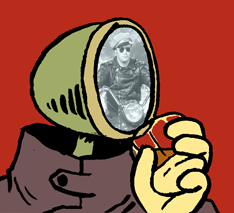As far as I can tell this is related to Benford’s law. The coin has to land sometime and at any given time it has spent as much or more time facing the way up it started, so it has more opportunities to land that way up. The fewer times it spins, the more pronounced the effect.
The fewer times it spins, the more pronounced the effect.
That accords with the finding that each flipper had a different average bias (if each flipper has a characteristic spin rate).
I remember trying to show this in math class in jr. high. I would deliberately try to flip the coin in the same fashion each time. I was able to get something like a 70/30 split out of 100 flips.
The coin has to land sometime and at any given time it has spent as much or more time facing the way up it started, so it has more opportunities to land that way up. The fewer times it spins, the more pronounced the effect.
I think that’s only relevant for coin flips which last for less than half a spin. Probably much less, considering momentum.
So maybe this means that 0.8% of all coin flips make less than half a flip. They basically just throw the coin up, without changing it’s rotation?
I don’t see how the number of times it spins could have any effect, as 1 spin is equal to 3 spins, or 101 and 57895.
But it matters if the coin spins at all.
If you understand why it matters that it spins at all, you understand why it matters that on each 360 degree spin, it will be facing up for the first half of the spin. Think it through.
I honestly tried, thanks for the impulse.
on each 360 degree spin, it will be facing up for the first half of the spin.
Yes, and that’s decisive if the coin is stopped during that phase. It will be facing down for the second half of the spin, which is decisive if the coin is stopped in that phase instead.
Since coins can spin with different speeds and can be stopped after different periods of time, this should be somewhat random, once it’s spinning.
I think I got your point that on average, the coin is facing more up than down, since it started facing up. But I think that’s only relevant if the coin is stopped in that initial phase, before making at least half a spin.
Wait, are we approaching the same argument from different sides? If we assume a random distribution of spinning speeds and a random distribution of toss durations. Then there will be some coins which experience very slow rotation, and which are also caught early enough that they don’t complete even half a spin. These have to face up.
All the other combinations of spin and toss produce random faces.
It’s not like rolling a die, the toss has to end at a point in time and time is linear. T=1 must happen before T=2. At any given time, the difference between the amount of time spent facing up and facing down will be between 0 and T/2n where T is the total time spent in the air and n is the number of spins completed in T. The more times it spins, the smaller the maximum difference between the two but there will always be a difference. It has more chances to land face up than it does face down.
Get your head around Benford’s Law. It’s a headfuck but it’s true for certain data generating processes. A coin toss doesn’t produce the same kind of data but it is the equivalent process for a binary outcome.
E2A: actually, it is a bit like rolling a die (because they come to rest at time T too). But that’s a much more complicated problem because the die doesn’t just land, it bounces around a bit. There’s some stuff out there about this for craps and I guess it’s why the dice have to hit the back wall. Any edge due to technique must be small enough for casinos not to care about it.
When I was a kid I found through trial and error that by tossing a quarter and catching it a certain way I could seem to predetermine the outcome.
I just tried it and I’ve sadly lost the ability. Magic really does fade with adulthood.
Flip such that the maximum rotation is achieved, height should be a natural arc a few feet high, then with open palm, strike down at the coin like your smashing a fly on a tabletop, and snatch it out of the air.
My buddy Julian taught me this 40 years ago… Doing it right now and I can still make it come heads every time. Why though?
Well, you basically determined the number of turns the coin took.
Kids are stupid, what can I say?
I’m still kind of a kid at heart, in that way.
Yeah, I could time the flips and almost 9 times out of 10 “guess” which side it was going to be. I’m not going to lie and say that I didn’t game the absolute fuck out of that ability as a kid. We played street sports all the time, so it was pretty handy.
deleted by creator
Spent that shit on single candies at the Mr. Bill.
The best way to flip a coin is to flip it, then base your decision on your reaction to the result of the coin flip.
Hm… It landed heads, which means you get to kill me. This makes me feel disappointed. Lets just say it landed tails.
Totally. It reveals what you really wanted.
I am not surprised. Part of the 50/50 idea is that people can toss the coin high enough to make an unpredictable number of turns. Which they can’t. I’d be interested in the information how many turns such a coin made before it landed. I’d expect to see a Gauss distribution here, with the center sufficiently off to explain the difference to a true 50/50.
i’d more say the point is that you don’t know if it’s gonna be heads or tails, sure maybe one is 60% likely but unless you go out of your way to statistically analyze your flips it’s still perfectly fine for randomly determining between two choices. where it doesn’t matter which one you go with.
I mean yeah they’re different weights on each side. Sand one side, Polish the other and flip them in a vacuum.
The article mentions that’s irrelevant. It’s slightly biased towards the side it started on, no matter if it’s heads of tails.
I mentioned it because as far as I saw they did not specify what coin they used.
I should be specific, they say 4⁰ someodd coins but don’t mention a control coin or the effect of air.
I mentioned it because as far as I saw they did not specify what coin they used.
You haven’t actually read the article, have you?
(…) the authors of the new paper conducted 350,757 flips, using different coins from 46 global currencies to eliminate a heads-tail bias between coin designs. (They also used a variety of people to rule out individuals with biased flipping techniques corrupting the results.) Regardless of the coin type, the same-side outcome could be predicted at 0.508, which rounds up perfectly to Diaconis’ “about 51 percent” prediction from 16 years ago.
I should be specific, they say 4⁰ someodd coins but don’t mention a control coin or the effect of air.
You should probably reign in that snark as i specifically addressed your point.
Notably every coin has a face/tail bias because of how much material is removed for the design, a coin with no bias flipped in vacuum should have been the control to remove the design and/or air resistance.
Never tell me the odds!
“I make my own luck”
You should worry when you flip a coin and it vanishes with a sharp “spang!”, followed by a thunderclap.
Did anyone actually read the article? It said it’s actually a 50.8% chance the side up before flipped will be the one up upon landing. Basically even
the small difference has no reason to be, and give you better odd of winning than being a pro at BlackJack









